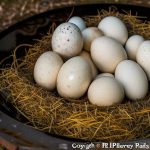Nurturing goslings is not just about ticking off a list of tasks—it’s an engaging journey that bonds you with nature’s fluffiest gifts. If you find yourself wondering how to kickstart this process or perhaps are anxious about ensuring their proper growth and health, know that your concerns are shared by many compassionate caretakers.
Fear not, for assistance is within reach! Armed with the right knowledge and care—such as providing a constant supply of fresh, clean water—you can step forward on this path confidently.
I have dedicated numerous hours investigating what it takes to fulfill their dietary needs and create the warmest environments for them. This article will guide you through every phase of rearing your little feathered companions so they flourish from tiny goslings into full-fledged adults.
Are you ready? Let’s embark on making certain our gosling friends get nothing but top-notch nurture!
Before the Arrival of Goslings
Before the arrival of goslings, it’s important to prepare a suitable brooder for them and provide warmth and water. Proper preparation will ensure their safety and well-being from the moment they arrive.
Preparing the brooder
I need to set up a safe and cozy spot for my new goslings. A well-prepared brooder ensures they stay warm and healthy.
- First, I find a sturdy box or tub that’s big enough for the growing birds.
- I line the bottom with absorbent materials like pine shavings or straw for bedding.
- Next, I install a heat lamp securely above the brooder to maintain a warm temperature.
- The temperature starts at 90°F and I reduce it by 5°F each week as they grow.
- I make sure the brooder is placed in a draft – free area to keep my goslings away from cold breezes.
- To check warmth levels, I put a reliable thermometer at their level in the brooder.
- It’s important to observe the goslings’ behavior; if they’re huddling under the lamp, they’re too cold.
Providing warmth and water
To care for goslings, ensure they have constant access to fresh, clean drinking water. Water helps with digestion and hygiene. Use a sturdy water fount and base to prevent spillage and keep the water clean. Never offer food without also providing water. Keep goslings dry in their living space for the first few weeks, especially in cool weather. In hot weather, ensure they stay cool and comfortable. Introduce finely-milled or crumble chick starter feed from 0-2 weeks old. From 3 weeks until they produce their first egg, offer grower feed. Encourage proper behavior by treating geese as livestock and not pets. Provide a big bucket of clean water every day for geese to immerse their heads in it. Gradually introduce goslings to water, starting with a small pan and increasing exposure as they age.
Feeding Goslings
Choose appropriate food and supplements for your goslings, ensuring they receive the essential nutrients for healthy growth. Introduce water as early as possible to prevent dehydration and aid in digestion.
Appropriate food and supplements
As a geese keeper, it’s crucial to provide the right nutrition for goslings. Here’s what you need to know:
- Goslings from 0-2 weeks old can be fed finely-milled or crumble chick starter feed, ensuring they get essential nutrients for growth and health.
- From 3 weeks old until they produce their first egg, goslings can transition to grower feed, which supports their development into healthy adult geese.
- Along with regular feed, consider providing supplements like grit and oyster shell to promote proper digestion and strong eggshells in mature geese.
- Always ensure access to fresh, clean drinking water alongside feeding to aid in digestion and overall well-being.
- Avoid hand – feeding and cuddling as these behaviors may lead to improper socialization of geese.
Introducing water
When raising goslings, providing access to fresh water is crucial for their well-being. Goslings use water not only to stay hydrated but also to help them digest their food and keep themselves clean.
It’s important to ensure that the water fount and base are sturdy so that they don’t get knocked over into the litter, keeping their living space clean.
Starting at around 2 weeks old, goslings can be gradually introduced to water. Initially, a small pan of water can be provided, leading up to larger containers as they grow older. It’s essential to monitor them closely during this introduction phase and ensure that they do not become chilled or wet in cool weather.
Establishing proper hydration habits early on will contribute significantly to the health and development of your goslings.
Living Space for Goslings
Choosing suitable bedding is crucial for the comfort and health of your goslings. Proper maintenance and cleaning of their living space also play a significant role in keeping them happy and healthy.
Providing outside access can also greatly benefit their development and overall well-being.
Choosing suitable bedding
To provide suitable bedding for goslings, here are essential considerations:
- Use straw or wood shavings as bedding materials to create a comfortable and warm environment.
- Ensure that the bedding is clean, dry, and free from molds or toxins to promote healthy development.
- Replace bedding regularly to maintain cleanliness and minimize the risk of bacterial contamination.
- Avoid using cedar shavings as they can be harmful to goslings’ respiratory health.
- Provide enough bedding to keep goslings warm and cushioned from the hard floor of their living space.
- Monitor the bedding regularly for signs of dampness or soiling, and replace as needed to ensure a hygienic environment for the goslings.
- Adjust the thickness of the bedding based on environmental conditions to maintain optimal warmth for the goslings.
Proper maintenance and cleaning
To maintain a clean living space for goslings:
- Regularly remove soiled bedding and replace with fresh, dry material to prevent bacteria buildup.
- Clean the brooder or living area thoroughly at least once a week using a mild disinfectant to reduce the risk of disease transmission.
- Ensure good ventilation in the living space to minimize odors and maintain a healthy environment.
- Keep food and water containers clean, refilling them with fresh supplies daily to prevent contamination.
- Monitor the goslings’ health and behavior closely, promptly addressing any signs of illness or distress.
Outside access
Goslings need to be kept out of the rain and off wet grass for the first few weeks, especially in cool weather. In hot weather, it’s important to keep goslings cool and comfortable.
Consider providing a shaded area outside where they can enjoy fresh air without being exposed to direct sunlight or harsh elements.
It’s essential that geese have access to a nice, big bucket of clean water every day so they can immerse their heads in it. As your goslings grow older, you can introduce them gradually to water, starting with a small pan and increasing their exposure over time.
Social Considerations for Goslings
When it comes to raising goslings, it’s important to consider their social needs. Providing companionship for your goslings is essential for their mental and emotional well-being. Solitary goslings may experience stress and loneliness, so be sure to provide them with appropriate company as they grow.
Importance of companionship
Goslings need companionship to thrive and feel secure. They enjoy being around other geese, which helps prevent loneliness and stress. Providing them with social interaction from a young age contributes to their overall well-being, forming strong bonds among the flock.
It is crucial to introduce goslings to other geese early on so they can establish pecking orders and learn vital behaviors within their community. Loneliness can lead to developmental issues in goslings, so ensuring they have companionship is essential for their mental and emotional development as they grow.
Concerns for solitary goslings
When raising goslings, it’s crucial to address the concerns of solitary geese. Solitary goslings may experience stress and anxiety, leading to behavioral issues and stunted social development.
They thrive in groups with companionship, which is essential for their overall well-being. Lack of social interaction can affect their mental and emotional health.
To prevent the negative impact of solitude on goslings, consider introducing them to a small flock early on or providing them with a mirror or stuffed animal as temporary companions.
Health and Growth of Goslings
Goslings, just like any young animals, are susceptible to a range of health issues such as infections and nutritional deficiencies. It’s important to monitor their growth closely and introduce appropriate feed and supplements to ensure they develop properly into healthy adult geese.
Common health issues
Having experience raising geese, I can share some common health issues to watch out for:
- Respiratory Infections: Geese are susceptible to respiratory illnesses caused by bacteria or viruses. Watch for signs like wheezing, coughing, and nasal discharge.
- Botulism: This potentially fatal illness can occur when goslings ingest food or water contaminated with the botulinum toxin, causing paralysis and difficulty breathing.
- Bumblefoot: This condition is characterized by swelling and infection of the foot pad, often caused by unsanitary living conditions. Regularly check their feet for any signs of swelling or injury.
- Aspergillosis: Mold spores in damp bedding can lead to this fungal infection, causing respiratory distress and lethargy in goslings.
- Parasites: Keep an eye out for external parasites like mites and lice, as well as internal parasites such as worms which can affect their overall health if left untreated.
- Leg Problems: Goslings may develop leg issues due to poor nutrition, improper bedding, or congenital defects. Observe their movements for any signs of lameness or difficulty walking.
Growth milestones and changes
As goslings grow, they will experience various developmental milestones and changes. These include:
- Feathers start to develop by the second week, starting from the wing and tail areas.
- By three weeks old, goslings begin to explore their environment more confidently.
- Goslings will triple their weight within the first ten days of life.
- At around five weeks old, young geese start to appear more like adults with full feathering.
- By eight weeks, goslings are fully feathered and ready to be transitioned to adult feed.
- The vocalizations of goslings change as they grow, developing distinct honks by six weeks of age.
- From 10 – 12 weeks old, geese reach sexual maturity with noticeable differences in behavior and posture.
- The downy fluff starts to be replaced by feathers at around four weeks old, especially on the neck and chest areas.
- By twelve weeks, goslings have reached close to adult size but may still exhibit some juvenile behaviors.
Transitioning to adulthood
As goslings near adulthood, their dietary needs evolve. It’s essential to transition them from grower feed to a suitable layer feed once they reach the age of egg production. Additionally, provide calcium supplements such as crushed oyster shells for strong eggshells.
Exercise and outdoor exposure become crucial for adult geese, allowing them to graze and forage for greens while maintaining proper nutrition through a balanced diet. Remember that adult geese need ample clean water daily, so ensure they have access to swimming areas or shallow pools in addition to their drinking water.
Geese behavior may also change during this phase as they establish social hierarchies among themselves. Introduce new birds carefully if expanding your flock and provide adequate space to avoid overcrowding issues which can lead to aggression and stress-related health problems.
Conclusion
In conclusion, caring for goslings involves providing warmth, clean water, suitable bedding and proper nutrition. These practical tips are easy to implement and efficient for raising healthy geese.
Implementing these strategies can lead to significant improvements in the growth and well-being of your goslings. Consider exploring additional resources or seeking further guidance to enhance your knowledge about gosling care.
Take action today to ensure the best care for your goslings and experience joy in watching them grow into healthy adult geese.
FAQs
1. What do I need to know about gosling care?
When caring for goslings, it’s important to provide proper bedding, ensure they have access to clean water and the right nutrition, and keep them warm.
2. How can I keep my goslings healthy?
Keep your goslings healthy by offering a balanced diet, protecting them from extreme temperatures, managing their housing well, and watching their behavior for signs of illness.
3. Can you give tips on feeding baby geese?
Yes, providing homemade food options rich in nutrients is essential for good gosling feeding practices. Also make sure they always have fresh water available.
4. When is it safe for goslings to go into the water?
Goslings can go in water when their feathers grow in enough to keep them dry but watch closely since they tire easily and shouldn’t be left unattended.
5. What should I use for Gosling bedding?
For Gosling Bedding options choose materials that will stay dry and provide comfort like straw or wood shavings; this helps prevent leg damage and keeps your geese care routine effective.
Meet Walter, the feathered-friend fanatic of Florida! Nestled in the sunshine state, Walter struts through life with his feathered companions, clucking his way to happiness. With a coop that’s fancier than a five-star hotel, he’s the Don Juan of the chicken world. When he’s not teaching his hens to do the cha-cha, you’ll find him in a heated debate with his prized rooster, Sir Clucks-a-Lot. Walter’s poultry passion is no yolk; he’s the sunny-side-up guy you never knew you needed in your flock of friends!








I found this a great help with my first joyful experience of goslings.
Thank you for your kind words!